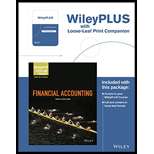
(a)
Note receivable:
Note receivable refers to a written promise by the debtor for the amounts to be received within a stipulated period of time. This written promise is issued by a debtor or, a borrower to the lender or, creditor. Notes receivable is an asset of a business.
Interest on note:
Interest on note is the amount charged on the principal value of note, for the privilege of borrowing money. Interest is to be paid by the borrower, and to be received by the lender.
Maturity date:
Maturity date is the due date on the note receivable. On due date, the borrower is supposed to repay the face value of the note, along with the interest.
The missing amount of total interest, and maturity date for the note issued on April 1.
(b)
The missing maturity date and annual interest rate for the note issued on July 2.
(c)
The missing amount of total interest and maturity date for the note issued on March 7.
Want to see the full answer?
Check out a sample textbook solution
Chapter 8 Solutions
Financial Accounting, 10e WileyPLUS Registration Card + Loose-leaf Print Companion
- Anderson Footwear Ltd. produces high-performance hiking boots. Each pair requires $34.80 in variable raw material costs and $24.60 in variable labor expenses. The boots sell for $168 per pair. Last year, the company produced 95,000 pairs. Fixed costs for the year were $1,460,000. Required: a. What were total production costs? b. What is the marginal cost per pair? c. What is the average cost per pair? d. If the company is considering a one-time special order for an additional 6,000 pairs, what is the minimum acceptable total revenue from the order?arrow_forwardWhat Is the amount of the check??arrow_forwardIn step acquisition accounting, what is the previously held interest? (a) Written off to reserves (b) Maintained at original cost (c) Ignored in consolidation (d) Remeasured to fair value MCQarrow_forward
- calculate the total materials variance and indicate whether it is favorable or unfavorable .....?arrow_forwardI am looking for the correct answer to this financial accounting problem using valid accounting standards.arrow_forwardCan you help me solve this general accounting question using the correct accounting procedures?arrow_forward
- Solve with explanation and accounting questionarrow_forwardVito’s Veggie Rolls prepares 120 rolls every day and sells them at $19 per piece. For each roll, he spends $9.50 on raw materials. Additionally, he spends $1.10 for packing each roll and monthly $60, $20, and $15 for food cart rent, electricity, and other expenses respectively. Lost sales are considered to cost $1.50 per unhappy customer. Leftover rolls can be sold for $5.50 each. On a particular day in July, due to an unexpected strike, Vito was able to sell only 95 rolls. Assume there are 30 days in the month. Determine Vito’s profit for that day.arrow_forwardsubject general accountingarrow_forward

 AccountingAccountingISBN:9781337272094Author:WARREN, Carl S., Reeve, James M., Duchac, Jonathan E.Publisher:Cengage Learning,
AccountingAccountingISBN:9781337272094Author:WARREN, Carl S., Reeve, James M., Duchac, Jonathan E.Publisher:Cengage Learning, Accounting Information SystemsAccountingISBN:9781337619202Author:Hall, James A.Publisher:Cengage Learning,
Accounting Information SystemsAccountingISBN:9781337619202Author:Hall, James A.Publisher:Cengage Learning, Horngren's Cost Accounting: A Managerial Emphasis...AccountingISBN:9780134475585Author:Srikant M. Datar, Madhav V. RajanPublisher:PEARSON
Horngren's Cost Accounting: A Managerial Emphasis...AccountingISBN:9780134475585Author:Srikant M. Datar, Madhav V. RajanPublisher:PEARSON Intermediate AccountingAccountingISBN:9781259722660Author:J. David Spiceland, Mark W. Nelson, Wayne M ThomasPublisher:McGraw-Hill Education
Intermediate AccountingAccountingISBN:9781259722660Author:J. David Spiceland, Mark W. Nelson, Wayne M ThomasPublisher:McGraw-Hill Education Financial and Managerial AccountingAccountingISBN:9781259726705Author:John J Wild, Ken W. Shaw, Barbara Chiappetta Fundamental Accounting PrinciplesPublisher:McGraw-Hill Education
Financial and Managerial AccountingAccountingISBN:9781259726705Author:John J Wild, Ken W. Shaw, Barbara Chiappetta Fundamental Accounting PrinciplesPublisher:McGraw-Hill Education





